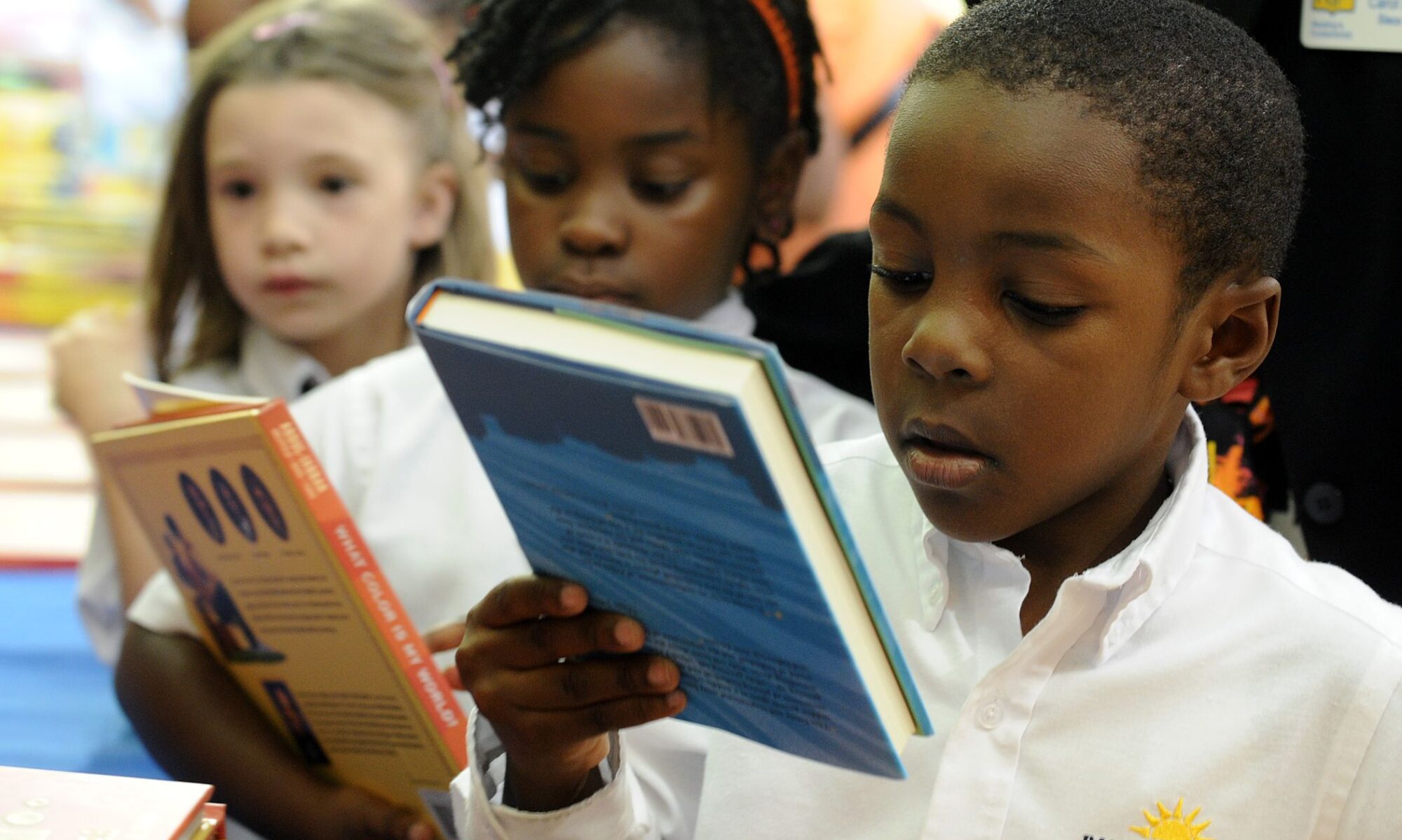Findings

Table of Contents
Survey Findings Summary
Survey Demographics
Survey Satisfaction Data
Activity Area Findings
Literature Review Findings
Survey Findings
Summary
Our preliminary BGCH cultural programming parent feedback survey had 14 responses from diverse racial backgrounds. All of the respondents to the survey were parents or guardians of one or more children attending one or more of the BGCH sites, and they chose 1 or 2 of the following cultural activity themes to focus their feedback: Indigenous Peoples’ Day, Black History Month, Women’s History Month, Hispanic Heritage Month, and Pride Month.
Our key survey findings are as follows:
-
- Overall, respondents indicated their satisfaction with current cultural activity programming at the Hartford Boys and Girls Clubs was somewhat satisfactory, with a mean score of 3.72, where 1 is “very unsatisfactory” and 5 is “very satisfactory.”
- Across all activities, those sampled reported the lowest satisfaction towards the accuracy of cultural activities, particularly Women’s History Month and Pride
- Hispanic History Month had the highest rate of overall satisfaction across the activity area themes
- Surveyed parents advocated for more music and art activities in Hispanic History Month and a greater emphasis on women change-makers in Women’s history month

Demographics
Race
Half of survey respondents identified as Black or African American, while 36% identify as Hispanic/Latine/Spanish and only 7% identify as White. One parent (7%) surveyed did not disclose their racial identity.

The BGCH site affiliated with the most respondents was the Asylum Hill BGCH, with 5 out of 14 respondents having children participate at their site. Followed by Asylum Hill, four responses come from parents with children enrolled at the South End BGCH, three responses came from parents with children enrolled at Metacomet Elementary School BGCH and two responses came from parents with children enrolled at Laurel Elementary School BGCH. The Southwest, Trinity College, and Joseph D. Lapenta Northwest BGCH branches had only one respondent affiliate.
BGCH Sites

While parents with children of all age groups responded to the survey, the highest number of respondents came from parents with younger children: 57% had children ages 9-11 and 36% had children ages 6-8. Only 14% of parents surveyed reported having children BGCH participants ages 12-14 and 15-18.
Age of Children

Satisfaction Data
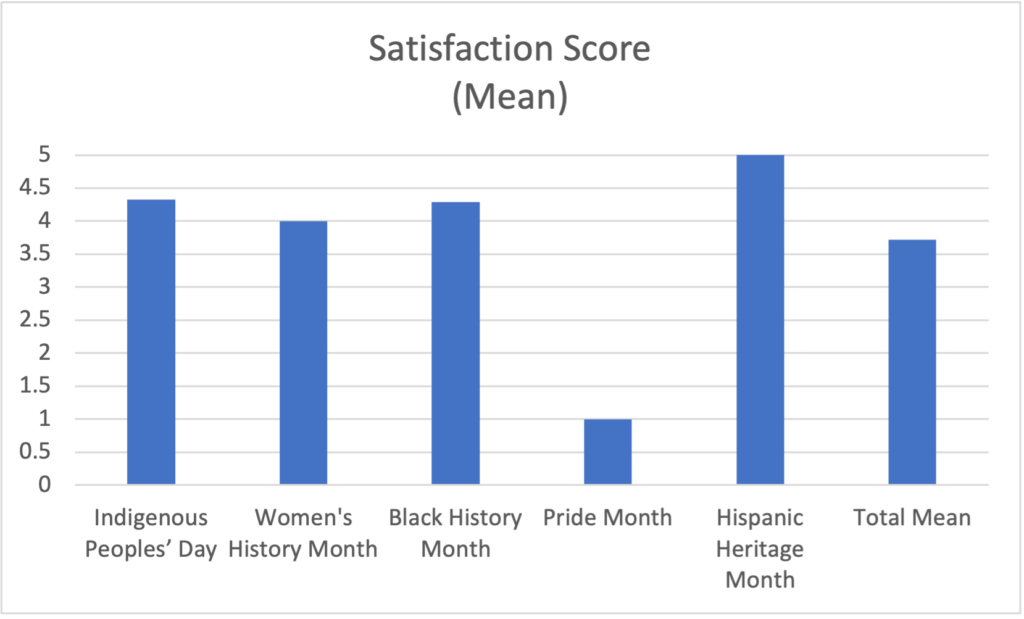
- Our results indicated that survey takers were most satisfied with Hispanic Heritage Month with the category receiving a mean satisfaction score of 5 (very satisfactory).
- Our results also showed that Pride Month programming was not as well received by its one respondent, with it receiving a mean satisfaction score of 1 (very unsatisfactory).
- Indigenous peoples’ Day, Women’s History Month and Black History Month all had mean satisfaction scores at or above 4 (satisfactory).
Activity Area Findings
Women’s History Month Findings

Demographics of Hispanic Heritage Month respondents:
- Two respondents total, both of them BGCH parents.
- Both respondents identified as Black.
Satisfaction
- While one respondent indicated that they were highly satisfied with the BGCH’s Women’s History Month programming overall, the other respondent stated that they were “unsure” of how satisfactory the Women’s History Month programming is.
- One respondent stated that there is “not enough” Women’s History Month programming and the other respondent stated that there is “enough” Women’s History month programming.
- BGCH parents sampled indicated they were between “satisfied” and “very satisfied” with the interdisciplinary components and enjoyment of Women’s History Month Activities.
- Parents surveyed reported that the cultural accuracy of the Women’s History Month programming is somewhat satisfactory.
- Both respondents reported that the Women’s History Month activities are age appropriate.
- One respondent expressed that they believe the Women’ History Month activities expand children’s cultural understanding, while one respondent reported that they did not believe so.
Additional feedback
- One parent surveyed suggested that the BGCH include more “women who have made a difference in the world” and “positive influential people” into their programming, implying a desire for the BGCH to provide activities centered on women leaders and change-makers.
- One respondent requested that “the programs be more detailed,” which implies an interest in more comprehensive lesson plans for Women’s History Month activities.
- Lastly, the respondent requested additional Women’s History Month activities to include cooking.
Hispanic History Month
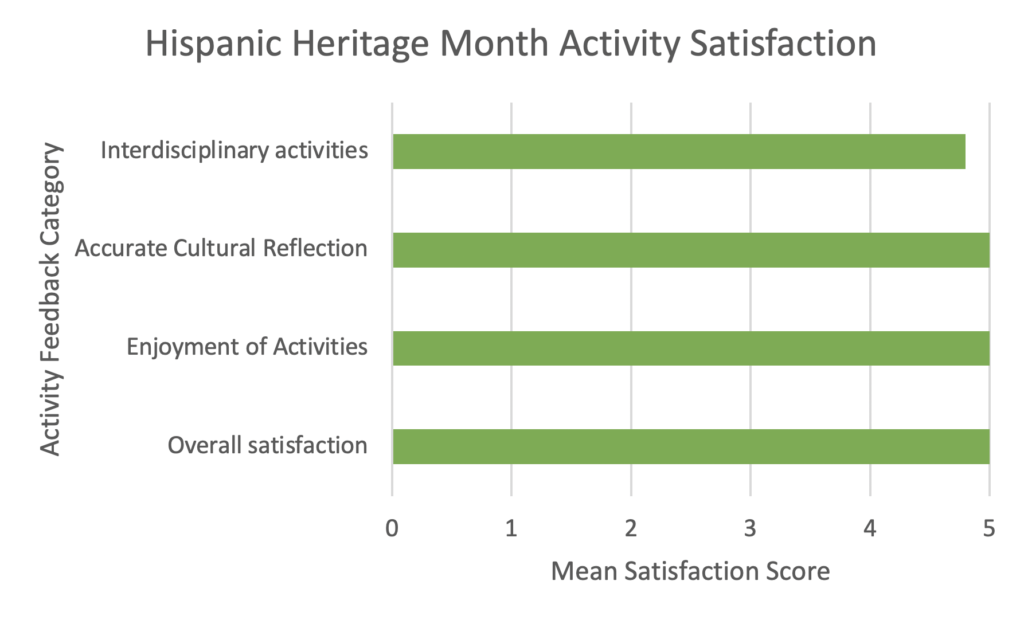
Demographics of Hispanic Heritage Month respondents:
- Four respondents total, all of them parents of BGCH youth.
- 3 respondents identified as Hispanic and 1 respondent identified as Black.
Satisfaction
- Two respondents expressed that the quantity of Hispanic Heritage Month programming is “enough” while one respondent expressed that it is “not enough.” No respondents stated that there is “too much” Hispanic Heritage Month programming.
- All respondents reported that the Hispanic Heritage Month programming developed youth’s cultural and historical understanding of Hispanic people.
- BGCH parents sampled all indicated they were “very satisfied” with Hispanic Heritage Month activities overall
- BGCH parents sampled indicated they were highly satisfied with activity enjoyment and cultural accuracy.
- All respondents reported that the BGCH Hispanic Heritage Month programming is age appropriate.
- For the interdisciplinary component of Hispanic Heritage Month activities, three parent respondents reported being “very satisfied” and one parent reported being “satisfied.”
Additional feedback
- Multiple parent respondents recommended exploring Hispanic art, music and literature in the BGCH activities (Héctor Lavoe, Esmeralda Santiago, Lin Manuel Miranda, Marc Anthony were all mentioned).
- One respondent recommended including more Caribbean-centered activities in the Hispanic Heritage Month curriculum.
Black History Month
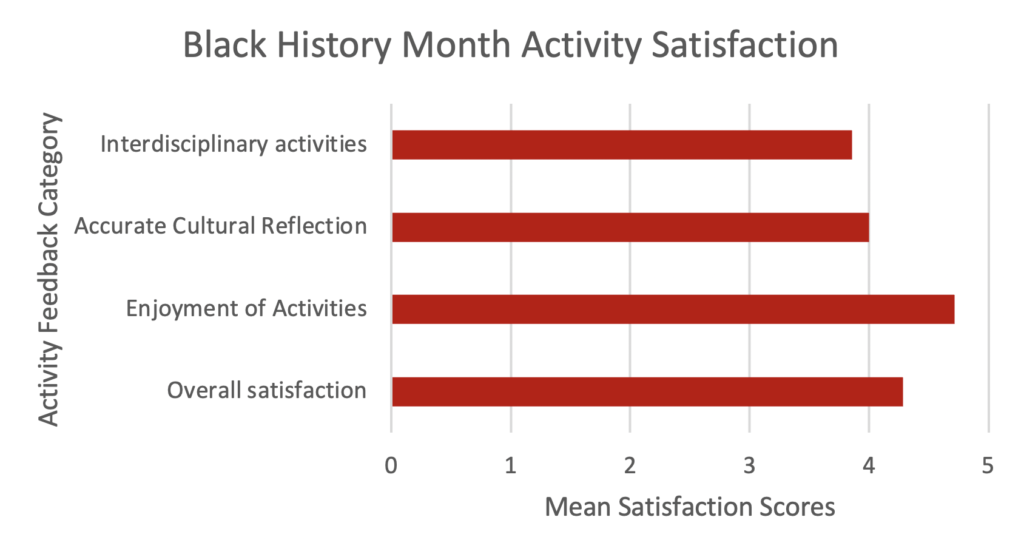
Demographics of Black History Month respondents:
- Seven respondents total, all of them parents of BGCH youth
- 5 respondents identified as Black, 2 respondents identified as Latine
Satisfaction
- Five respondents reported that there is “enough” Black History Month BGCH programming, while the other two Black History Month respondents suggested that there is “not enough” Black History Month programming.
- Six out of seven respondents indicated that the BGCH Black History Month programming helped youth understand Black/African-American culture and history.
- BGCH parents sampled indicated that they are overall satisfied with the Black History Month activity curriculum
- All parents sampled stated that the Black History Month BGCH activities are age appropriate.
- Parents sampled reported that they are satisfied with the cultural accuracy and interdisciplinary elements of the BGCH Black History Month curriculum
- For the enjoyment of BGCH Black History Month activities, surveyed parents indicated that they are “very satisfied.”
Additional feedback
- One parent sampled suggested that the “quiz bowl needed some work and more thought by staff.”
- Multiple parents requested more educational programming.
- Two respondents recommended more lessons on MLK and one parent recommended lessons on Barack Obama, Nelson Mandela and the Black Panther party.
Indigenous People’s Day

Demographics of Black History Month respondents:
- Three respondents total, all of them parents of BGCH youth
- Two respondents identify as Black, 1 respondent identifies as Hispanic/Latine
Satisfaction
- Those sampled indicated that they are “very satisfied” with the enjoyment and interdisciplinary components of the BGCH Indigenous Peoples’ Day activities.
- All individuals surveyed reported that they believe that the BGCH Indigenous Peoples’ Day programming enriches participants’ understanding of Indigenous culture and history.
- All parents sampled expressed that they believe that the Indigenous Peoples’ Day programming is age-appropriate.
- One respondent expressed that they were “very satisfied” with the BGCH Indigenous Peoples’ Day programming overall and two respondents indicated that they were “satisfied” with the BGCH Indigenous Peoples’ Day programming overall.
- The cultural accuracy of the Indigenous Peoples’ Day BGCH curriculum received the lowest satisfaction values among those sampled, with two respondents stating they were “satisfied” with the cultural accuracy and the other respondent saying they were “unsure.”
- All respondents selected that there is “enough” Indigenous People’s Day programming
Additional feedback
- Respondents provided no additional feedback on this subject area
Pride Month
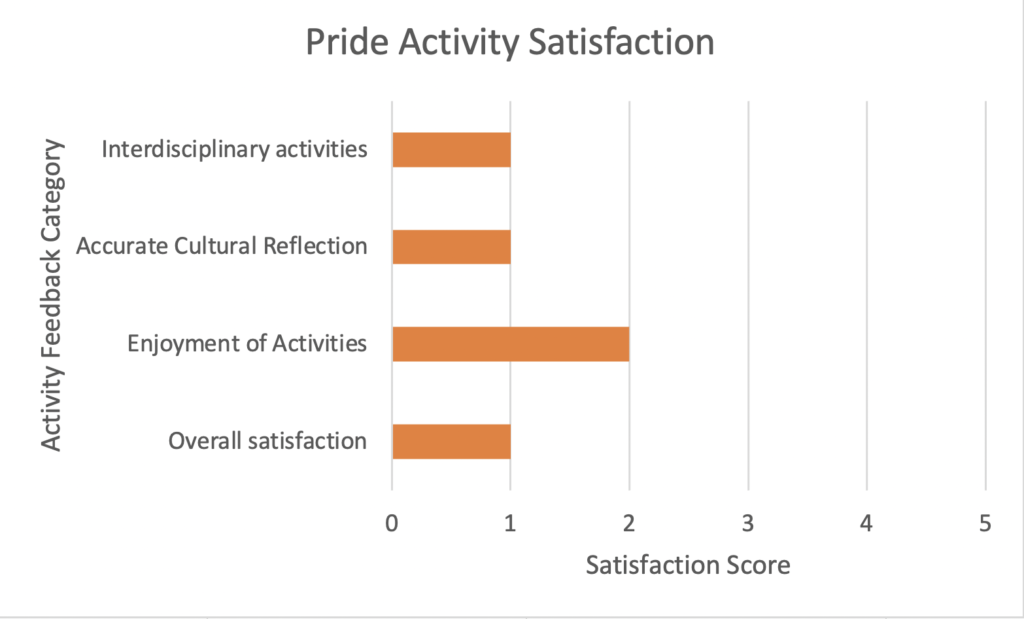
Demographics of Pride Month respondents:
- Only one respondent who is the parent of a BGCH participant
Satisfaction
- The respondent indicated that they are “very unsatisfied” with the overall activity programming, cultural accuracy, and interdisciplinary components of the BGCH Pride month activities.
- The parent surveyed indicated that they did not believe that the Pride programming extended youth’s cultural or historical understanding of LGBTQ+ identities.
- The respondent expressed that the amount of Pride Month programming is “too much.”
Additional feedback
- The respondent communicated general reservations on Pride programming being taught to children.
- The respondent stated that LGBTQ+ education should not be taught to children except for a broad message of accepting other people’s differences.
Literature Review Findings
To build our literature review, our team reviewed an abundance of sources describing features of effective afterschool programming, well-presented activities that emphasize cultural responsiveness, and the behavioral and social outcomes that marginalized youth experience when exposed to organized, culturally affirmative learning.
Through that review, our team organized a few conclusions that address the relationship between culturally constructive education systems and productive out-of-school time.
- First, we found that after school programs that prioritize cultural responsiveness tend to foster several positive benefits for youth, developments that stimulate agency and support for specifically Black, Brown, women, and LGBTQ+ populations.
- With that context, we found that robust afterschool programming that centers cultural responsiveness at the core of the curriculum can be sustained through prioritizing a select few areas of concentration such as building caring relationships for youth, allowing youth a secure place to develop a sense of belonging, student voice, activism and parent involvement.
- However, we recognize that successes in maintaining quality culturally responsive activities for youth cannot be achieved without confronting the external systemic and social barriers that prevent ethnically and culturally diverse groups of young people from accessing educational and social services they need to thrive.
